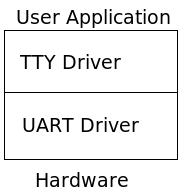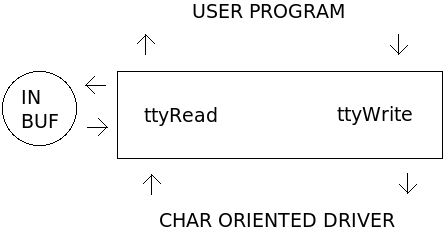Difference between revisions of "TTY Driver"
Jump to navigation
Jump to search
m |
|||
| Line 1: | Line 1: | ||
The TTY driver is built on top of the UART driver (or other TTY appropriate hardware). The driver is responsible for sending and receiving character input between a user program level, such as the XINU [[Shell]], and a char oriented hardware driver. Line buffering and cooking are the two primary responsibilities for the new TTY driver. | The TTY driver is built on top of the UART driver (or other TTY appropriate hardware). The driver is responsible for sending and receiving character input between a user program level, such as the XINU [[Shell]], and a char oriented hardware driver. Line buffering and cooking are the two primary responsibilities for the new TTY driver. | ||
| + | |||
[[Image:TtyUartInteraction.png]] | [[Image:TtyUartInteraction.png]] | ||
== Driver structure == | == Driver structure == | ||
[[Image:TtyDriver.png]] | [[Image:TtyDriver.png]] | ||
| + | |||
| + | ''This section needs updating'' | ||
| + | |||
| + | == Control == | ||
| + | ''This section needs updating'' | ||
== See also == | == See also == | ||
* [[Input Cooking]] | * [[Input Cooking]] | ||
* [[UART Driver]] | * [[UART Driver]] | ||
Revision as of 23:28, 14 June 2007
The TTY driver is built on top of the UART driver (or other TTY appropriate hardware). The driver is responsible for sending and receiving character input between a user program level, such as the XINU Shell, and a char oriented hardware driver. Line buffering and cooking are the two primary responsibilities for the new TTY driver.
Driver structure
This section needs updating
Control
This section needs updating

